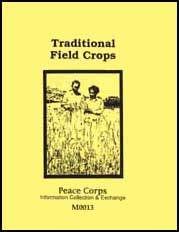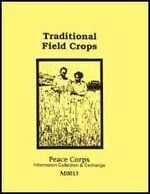
The Traditional Field Crops manual is designed as a learning tool and on-the-job reference for Peace Corps Volunteers involved in small farmer crop improvement programs in maize, sorghum, millet, peanuts, beans and cowpeas. Although written to be readily understood by nonspecialists, the manual contains much information useful to trained agriculturalists and to planners and trainers. Primarily designed to help Volunteers develop and strengthen the agricultural skills they need for successful work with the target crops, this manual focuses on the following areas:
- Surveying and interpreting the local agricultural environment and individual farm units
- Developing agricultural extension techniques and practices
- Providing basic "hands-on" and technical skills for extension workers in operations from farm land preparation through harvest, including some routine troubleshooting.
To do this, the manual provides a summary of current crop production recommendations under varying conditions of climate, soils, management ability, and available capital; identifies useful field references and other technical resources, including information on improvements in equipment for small farmer row crop production; and reviews recent research advances and extension efforts in target crop yield improvement with special emphasis on the role of international crop institutes. Scientific names are used along with common names to avoid confusion, as one common name may refer to a number of different species.
Copyright[edit | edit source]
Peace Corps' Information Collection & Exchange (ICE) was established so that the strategies and technologies developed by Peace Corps Volunteers, their co-workers and their counterparts could be made available to the wide range of development organizations and individual workers who might find them useful. Training guides, curricula, lesson plans, project reports, manuals and other Peace Corps-generated materials developed in the field are collected and reviewed. Some are reprinted "as is"; others provide a source of field based information for the production of manuals or for research in particular program areas. Materials that you submit to ICE thus become part of the Peace Corps' larger contribution to development.
Information about ICE publications and services is available through the Peace Corps Internet Web Site address: http://www.peacecorps.gov
Please note the new Peace Corps Mailing Address from July 1998 on is: Peace Corps/ICE, 1111 20th Street NW, Washington, DC 20526, USA
Add your experience to the ICE Resource Center. Send materials that you have prepared so that we can share them with others working in the development field. Your technical insights serve as the basis for the generation of ICE manuals, reprints, and resource packets, and also ensure that ICE is providing the most up-to-date, innovative problem-solving techniques and information available to you and your fellow development workers.
Written by: David Leonard
Edited by: Marilyn Chakroff Nancy Dybus
Illustrated by: Marilyn Kaufman
This publication was produced for Peace Corps by the Transcentury Corporation, Washington, D.C.
Peace Corps Information Collection & Exchange, December 1981
M0013
TRADITIONAL FIELD CROPS December 1981
Prepared for Peace Corps by the TransCentury Corporation under Contract No. 79-043-0129
Available through Peace Corps/ICE, 8th Floor, 1990 K Street, NW, Washington, DC 20526
About the author[edit | edit source]
David Leonard has been associated with the Peace Corps off and on for the past eighteen years. Originally a B.A. generalist (history), he served as an agriculture extension Volunteer in Guatemala from 1963-65 and then went on to get a Master of Agriculture degree in agronomy from Oregon State in 1967. Since then, he has been an agriculture trainer for 35 groups of Peace Corps Volunteers bound for Latin America, Africa, and Asia. He also grew maize, potatoes and peanuts for three years on a 120hectare farm in Australia.
Acknowledgments[edit | edit source]
I would like to express special thanks to John Guy Smith of Washington, D.C., for assistance in planning this manual and for permission to use materials from several of his publications. No one better understands the realities of small farmer agriculture and the development and introduction of improved farming practices.
Also, thanks are due to TranCentury's Paul Chakroff, Marilyn Chakroff and Nancy Dybus for their editing assistance; to Marilyn Kaufman for her fine illustrations; and to Cade Ware for his excellent typing and layout of the final document.
